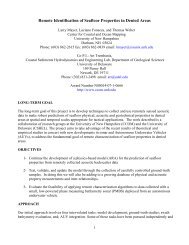paper title (up to 6 inches in width and centered - Georgia Institute of ...
paper title (up to 6 inches in width and centered - Georgia Institute of ...
paper title (up to 6 inches in width and centered - Georgia Institute of ...
- No tags were found...
Create successful ePaper yourself
Turn your PDF publications into a flip-book with our unique Google optimized e-Paper software.
AUVSI10-WestDESIGN AND DEVELOPMENT OF THE YELLOWFIN UUV FORHOMOGENEOUS COLLABORATIVE MISSIONSMichael E. West, * Michael Novitzky, Jesse P. Varnell, Andrew Melim, EvanSegu<strong>in</strong>, Tedd C. Toler, Tomas R. Coll<strong>in</strong>s, John R. Bogle, Matthew P. Bradley,<strong>and</strong> Andrew M. HenshawINTRODUCTION<strong>Georgia</strong> Tech Research <strong>Institute</strong> (GTRI) has developed the Yellowf<strong>in</strong>, a smallman-portable Unmanned Underwater Vehicle (UUV). The mission for Yellowf<strong>in</strong>is <strong>to</strong> conduct au<strong>to</strong>nomous collaborative operations. The multi-UUV designallows for a much wider swath <strong>of</strong> the ocean <strong>to</strong> be observed <strong>and</strong> moni<strong>to</strong>red, whilecollaborative operations allow multiple aspects <strong>of</strong> a mission <strong>to</strong> be tackled withdistributed systems. Both oceanographic <strong>and</strong> military missions are aided tremendouslyby the use <strong>of</strong> such a UUV network. This <strong>paper</strong> <strong>in</strong>troduces the modular<strong>and</strong> flexible design <strong>of</strong> the Yellowf<strong>in</strong> system <strong>and</strong> describes some <strong>of</strong> the technologies<strong>in</strong>tegrated with<strong>in</strong> the system construct. The system <strong>and</strong> s<strong>of</strong>tware architectures<strong>of</strong> Yellowf<strong>in</strong> leverage COTS technologies, <strong>in</strong>clud<strong>in</strong>g s<strong>of</strong>tware whosefoundation is MOOS-IvP, exp<strong>and</strong>ed <strong>to</strong> <strong>in</strong>clude several aspects <strong>of</strong> au<strong>to</strong>nomy,communication with the WHOI acoustics modem utiliz<strong>in</strong>g the JAUS messagest<strong>and</strong>ard, mission plann<strong>in</strong>g us<strong>in</strong>g MissionLab, mission execution via Falcon-View TM , front seat control with a microcontroller, <strong>and</strong> visualization with theBlender open-source, cross-platform suite <strong>of</strong> <strong>to</strong>ols for 3D graphics.Unmanned Underwater Vehicles (UUVs) have become <strong>in</strong>dispensable <strong>to</strong>ols for undersea scientific,military, <strong>and</strong> commercial applications. Us<strong>in</strong>g UUVs for Intelligence Surveillance <strong>and</strong> Reconnaissance(ISR), M<strong>in</strong>e countermeasures (MCM) <strong>and</strong> Anti-Submar<strong>in</strong>e Warfare (ASW) haveshown great potential. 1 UUVs have shown <strong>to</strong> be <strong>in</strong>valuable <strong>to</strong>ols for underst<strong>and</strong><strong>in</strong>g ocean behaviorssuch as Harmful Algal Blooms, Chemical transport (Nitrates <strong>and</strong> Hydrates) <strong>and</strong> the impac<strong>to</strong>f CO2 absorption. The current paradigm for the use <strong>of</strong> UUVs is a platform centric sens<strong>in</strong>gsystem. Our research looks at the use <strong>of</strong> multiple vehicles which would allow for a net centricdistributed sens<strong>in</strong>g system <strong>and</strong> <strong>in</strong>terrogate a much wider swath <strong>of</strong> the ocean. Currently, the USNavy’s planned deployment <strong>of</strong> UUVs emphasizes s<strong>in</strong>gle-vehicle operation through at least 2015with uncerta<strong>in</strong> capabilities for cooperat<strong>in</strong>g vehicles beyond that. 2 3 However, <strong>to</strong> reduce the overalltime <strong>and</strong> cost <strong>of</strong> acquir<strong>in</strong>g data over large unstructured areas, multiple vehicles must be used.To address this need, the <strong>Georgia</strong> Tech Research <strong>Institute</strong> (GTRI) has developed the Yellowf<strong>in</strong>UUV. See Figure 1.* Senior Research Eng<strong>in</strong>eer, Electronic Systems Labora<strong>to</strong>ry, <strong>Georgia</strong> Tech Research <strong>Institute</strong>, 400 W. 10th St. Rm. 272Atlanta, GA 30332-0829.1
Figure 1: Yellowf<strong>in</strong> CAD Draw<strong>in</strong>gThe Yellowf<strong>in</strong> is a man-portable UUV that weighs less than 17 lbs <strong>and</strong> was designed <strong>to</strong> s<strong>up</strong>portau<strong>to</strong>nomous homogeneous collaborative operations. Advances <strong>in</strong> multi-agent collaborativecontrol have been <strong>in</strong>tegrated <strong>in</strong><strong>to</strong> the system <strong>to</strong> au<strong>to</strong>nomously control <strong>and</strong> coord<strong>in</strong>ate multipleUUVs. The behavior modules were developed <strong>and</strong> implemented us<strong>in</strong>g the open-source MissionOriented Operat<strong>in</strong>g Suite (MOOS) architecture along with the Interval Programm<strong>in</strong>g (IvP) Helms<strong>of</strong>tware module. The MOOS architecture was co<strong>up</strong>led with MissionLab open-source s<strong>of</strong>tware<strong>to</strong>ols developed by <strong>Georgia</strong> Tech. This suite <strong>of</strong> s<strong>of</strong>tware is then used <strong>to</strong> develop <strong>and</strong> execute behaviorsfor both s<strong>in</strong>gle UUV au<strong>to</strong>nomy <strong>and</strong> for a team <strong>of</strong> au<strong>to</strong>nomous collaborat<strong>in</strong>g UUVs. Thisco<strong>up</strong>l<strong>in</strong>g <strong>of</strong> s<strong>of</strong>tware allowed for the development <strong>of</strong> highly capable UUVs us<strong>in</strong>g behavior-basedau<strong>to</strong>nomy. By us<strong>in</strong>g open source <strong>and</strong> st<strong>and</strong>ards-based development <strong>in</strong> the design <strong>of</strong> the Yellowf<strong>in</strong>,we have atta<strong>in</strong>ed a modular <strong>and</strong> adaptable suite <strong>of</strong> platforms that s<strong>up</strong>port flexibility <strong>in</strong> missionexecution. The design also deco<strong>up</strong>les the vehicle au<strong>to</strong>nomy logic from the mechanical control <strong>of</strong>the vehicle hardware, so that <strong>up</strong>grades <strong>and</strong> adaptations are readily <strong>in</strong>corporated. Yellowf<strong>in</strong> is alsodesigned <strong>to</strong> seamlessly <strong>in</strong>corporate different sensors <strong>and</strong> payloads, so that collaborative behaviorsenable coord<strong>in</strong>ation among the different vehicle sensors <strong>and</strong> configurations. The result is a st<strong>and</strong>ards-basedsystem capable <strong>of</strong> s<strong>up</strong>port<strong>in</strong>g <strong>in</strong>telligent au<strong>to</strong>nomy, from perception <strong>to</strong> situationalunderst<strong>and</strong><strong>in</strong>g <strong>to</strong> au<strong>to</strong>mated responses. The <strong>paper</strong> presents the foundations <strong>of</strong> the Yellowf<strong>in</strong> design.YELLOWFIN DESIGNA number <strong>of</strong> design challenges exist for the development <strong>of</strong> man-portable UUVs. Becausespace is at a premium, all <strong>of</strong> the electronics for power, communications, sensors, computation,<strong>and</strong> actuation, along with their packag<strong>in</strong>g, must be carefully considered. A constant trade<strong>of</strong>f betweencost <strong>and</strong> development time must be mitigated, <strong>and</strong> the use <strong>of</strong> commercially available <strong>of</strong>fthe-shelfcomponents must be leveraged when possible. Figure 2 presents the high-level designprocess.2
Figure 2: Yellowf<strong>in</strong> Design ApproachDesign ApproachYellowf<strong>in</strong> was designed <strong>to</strong> rapidly provide a solid foundation <strong>of</strong> <strong>in</strong>tegrated basel<strong>in</strong>e functionalitywhile still be<strong>in</strong>g adaptable <strong>to</strong> a wide range <strong>of</strong> mission-specific requirements. To keep cost<strong>and</strong> development time as low as possible while ma<strong>in</strong>ta<strong>in</strong><strong>in</strong>g the quantity <strong>and</strong> quality <strong>of</strong> vehiclefeatures along with system <strong>in</strong>teroperability, the design <strong>of</strong> Yellowf<strong>in</strong> adopted COTS (Commercial,<strong>of</strong>f-the-shelf) components, open-source s<strong>of</strong>tware, <strong>and</strong> <strong>in</strong>dustry st<strong>and</strong>ards whenever feasible. Thevehicle itself was designed through an iterative process where one pro<strong>to</strong>type was designed, built,<strong>and</strong> tested followed by several additional vehicles. The s<strong>of</strong>tware design also progressed <strong>in</strong> stageswith the results <strong>of</strong> the implementation motivat<strong>in</strong>g additional cycles <strong>of</strong> design work.Design GoalsThe <strong>in</strong>itial design goals generated requirements that were categorized <strong>in</strong><strong>to</strong> two primary areas:mission requirements <strong>and</strong> vehicle requirements 43
Mission requirementsThese are specific <strong>to</strong> the mission that Yellowf<strong>in</strong> will perform. While Yellowf<strong>in</strong> is capable <strong>of</strong>perform<strong>in</strong>g a diverse category <strong>of</strong> missions, there is a core set <strong>of</strong> features that is common <strong>to</strong> therequirements <strong>of</strong> most UUV missions. These <strong>in</strong>clude- Control, navigation, <strong>and</strong> collaborative behaviors- Validation through real <strong>and</strong> simulated test<strong>in</strong>g- Suitability for multiple applications, <strong>in</strong>clud<strong>in</strong>g oceanographic <strong>and</strong> military researchVehicle requirementsThese are specific <strong>to</strong> the Yellowf<strong>in</strong> vehicle. Particular values for performance specificationsare determ<strong>in</strong>ed by exam<strong>in</strong><strong>in</strong>g the requirements for various applications <strong>and</strong> were chosen <strong>to</strong> mee<strong>to</strong>r exceed those requirements.- Operat<strong>in</strong>g speed > 2 knots- Operat<strong>in</strong>g duration > 10 hours- Max weight < 17 lbs- Cost < $30K- Ability <strong>to</strong> accommodate various sensor <strong>and</strong> payloadsResult<strong>in</strong>g designCo<strong>up</strong>l<strong>in</strong>g the mission <strong>and</strong> vehicle requirements resulted <strong>in</strong> a vehicle design with the follow<strong>in</strong>gfeatures. Figure 3 shows a fully assembled Yellowf<strong>in</strong>.- Length: 889mm- Diameter: 123.8mm- Weight: 7.7kg- Front Seat/Back Seat Driver S<strong>of</strong>tware Paradigm- Modular, Behavior-Based Au<strong>to</strong>nomy- Mission Oriented Operat<strong>in</strong>g Suite (MOOS)- JAUS InterfacesFigure 3: Fully Assembled Yellowf<strong>in</strong>4
SUBSYSTEM OVERVIEWCommunicationsAcoustic communications are enabled through a WHOI micro-modem, which is usedthroughout the UUV community <strong>and</strong> allows the Yellowf<strong>in</strong> <strong>to</strong> communicate underwater over fairlylong distances at very low b<strong>and</strong><strong>width</strong>. Wi-Fi provides a high b<strong>and</strong><strong>width</strong> data l<strong>in</strong>k when the Yellowf<strong>in</strong>is at the surface <strong>of</strong> the water, but does not work underwater. Radio frequency (RF) communicationsfall <strong>in</strong>-between the acoustic <strong>and</strong> Wi-Fi <strong>in</strong> terms <strong>of</strong> b<strong>and</strong><strong>width</strong> <strong>and</strong> works both above<strong>and</strong> below water (moderately well). Yellowf<strong>in</strong> is also equipped with an optional Ethernet tetherthat s<strong>up</strong>ports <strong>in</strong>-water drive test<strong>in</strong>g, evaluation <strong>of</strong> new capabilities, <strong>and</strong> high-b<strong>and</strong><strong>width</strong> connectionswhen the Yellowf<strong>in</strong> is docked. Yellowf<strong>in</strong> uses an open-source implementation <strong>of</strong> the Jo<strong>in</strong>tArchitecture for Unmanned Systems (JAUS) message pro<strong>to</strong>col called OpenJAUS. * OpenJAUSprovides a library <strong>of</strong> message rout<strong>in</strong>es that code <strong>and</strong> decode a variety <strong>of</strong> JAUS message types <strong>in</strong>clud<strong>in</strong>gsystem health, UUV pose, mission directives, <strong>and</strong> sensor data communication. The Yellowf<strong>in</strong>s<strong>of</strong>tware also <strong>in</strong>cludes a library <strong>of</strong> rout<strong>in</strong>es that encode <strong>and</strong> decode the JAUS messages<strong>in</strong><strong>to</strong> <strong>and</strong> out <strong>of</strong> the NMEA 0183 st<strong>and</strong>ard pro<strong>to</strong>col utilized by the WHOI acoustic modems.Figure 4: Yellowf<strong>in</strong> Communications* http://www.openjaus.com5
SensorsYellowf<strong>in</strong> has many <strong>of</strong> the most common navigational sensors, <strong>in</strong>clud<strong>in</strong>g GPS, IMU, compass,<strong>and</strong> pressure sensor. These are used for low-level motion control <strong>and</strong> for high-level localization.Yellowf<strong>in</strong> also <strong>in</strong>cludes moisture sensors for leak detection <strong>and</strong> a BlueView forwardimag<strong>in</strong>gsonar. In contrast with traditional sonars where a s<strong>in</strong>gle beam is mechanically rotated,imag<strong>in</strong>g sonars implement multi-beam sensors that form several small acoustical beams at once.Imag<strong>in</strong>g sonar is effective on mov<strong>in</strong>g platforms, whereas movement <strong>of</strong> traditional sonars dur<strong>in</strong>gvehicle operation can cause data errors. Yellowf<strong>in</strong> uses the sonar <strong>in</strong> several ways, but this sonarspecifically enables simultaneous localization <strong>and</strong> mapp<strong>in</strong>g (SLAM). See Figure 4. Other sensors<strong>and</strong> payloads can be easily <strong>in</strong>corporated <strong>in</strong><strong>to</strong> various-sized nose cones for Yellowf<strong>in</strong>.ComputationProcess<strong>in</strong>g on the Yellowf<strong>in</strong> is split <strong>in</strong><strong>to</strong> two sections: a low-level processor, which managesall hardware <strong>and</strong> s<strong>of</strong>tware <strong>in</strong>tegral <strong>to</strong> the sensors <strong>and</strong> actua<strong>to</strong>rs, <strong>and</strong> a high-level processor,which manages the au<strong>to</strong>nomy <strong>and</strong> collaborative behaviors. The so-called “Backseat-driver” paradigmallows for the deco<strong>up</strong>l<strong>in</strong>g between high-level <strong>and</strong> low-level control. 5 This dual architecturewas created <strong>to</strong> reduce the difficulty <strong>of</strong> modify<strong>in</strong>g the more complex high-level s<strong>of</strong>tware <strong>and</strong><strong>to</strong> make the s<strong>of</strong>tware platform-<strong>in</strong>dependent. It also reduces the risk <strong>of</strong> the less stable high-levels<strong>of</strong>tware <strong>in</strong>terfer<strong>in</strong>g with safety-critical low-level s<strong>of</strong>tware. The low-level <strong>and</strong> high-level processorsare able <strong>to</strong> communicate <strong>in</strong> a reasonably fast manner (high b<strong>and</strong><strong>width</strong>, low latency) <strong>to</strong> exchangedata.S<strong>of</strong>twareFigure 4: Yellowf<strong>in</strong>’s Sonar GUI Track<strong>in</strong>g BuoysThe Yellowf<strong>in</strong> has a complete s<strong>of</strong>tware package from pre-mission plann<strong>in</strong>g <strong>to</strong> mission execution.See Figure 5. The pre-mission plann<strong>in</strong>g is performed by Mission Lab by organiz<strong>in</strong>g availablebehaviors <strong>to</strong> generate mission behaviors. Mission execution on the vehicle is performed us<strong>in</strong>gthe MOOS-IvP suite <strong>of</strong> applications for high-level au<strong>to</strong>nomy <strong>and</strong> an XMOS low level controller.Comm<strong>and</strong> <strong>and</strong> control is performed at a base station, us<strong>in</strong>g FalconView. A mission can be ex-6
ecuted <strong>in</strong> the Yellowf<strong>in</strong> simula<strong>to</strong>r or on the actual vehicles.Figure 5: Yellowf<strong>in</strong>'s S<strong>of</strong>tware For Mission ExecutionMission Plann<strong>in</strong>gYellowf<strong>in</strong> uses MissionLab for pre-mission plann<strong>in</strong>g. MissionLab was created at the <strong>Georgia</strong><strong>Institute</strong> <strong>of</strong> Technology for the purposes <strong>of</strong> organiz<strong>in</strong>g <strong>and</strong> execut<strong>in</strong>g behavior-based architectures.6 In particular, Yellowf<strong>in</strong> has a database <strong>of</strong> behaviors that can be organized for a particularmission based on requirements through the use <strong>of</strong> a GUI application. See Figure 6. This GUItranslates the organized behaviors <strong>in</strong><strong>to</strong> mission files which Yellowf<strong>in</strong>’s au<strong>to</strong>nomy can executedur<strong>in</strong>g mission deployment.7
Figure 6: Mission Lab's Behavior-based GUIComm<strong>and</strong> <strong>and</strong> control <strong>of</strong> multiple UUVs is performed through a base station us<strong>in</strong>g the opensource FalconView TM* S<strong>of</strong>tware. FalconView TM is widely used by the United States Departmen<strong>to</strong>f Defense for its aircraft mission plann<strong>in</strong>g <strong>and</strong> mapp<strong>in</strong>g capabilities <strong>and</strong> has over 40,000 users.FalconView TM provides for application extensions through a plug-<strong>in</strong> framework. The UUVs <strong>in</strong>this system can communicate <strong>to</strong> a base station server when or as needed through the Yellowf<strong>in</strong>communication system, <strong>and</strong> the FalconView TM application plug-<strong>in</strong> displays the vehicles’ positions<strong>and</strong> telemetry <strong>in</strong>formation <strong>in</strong> real time us<strong>in</strong>g JAUS messages. The base station can also beused <strong>to</strong> send JAUS messages <strong>to</strong> the vehicles, such as waypo<strong>in</strong>t <strong>and</strong> mission-based comm<strong>and</strong>s.* http://www.falconview.org8
Figure 7: FalconView TM Mission Plann<strong>in</strong>g S<strong>of</strong>twareCollaborative Au<strong>to</strong>nomyThe high-level s<strong>of</strong>tware architecture <strong>and</strong> au<strong>to</strong>nomy for Yellowf<strong>in</strong> is provided by MOOS <strong>and</strong>MOOS-IvP, respectively. 7 MOOS is C++ cross-platform middleware, created <strong>and</strong> ma<strong>in</strong>ta<strong>in</strong>ed bythe Oxford Mobile Robotics Gro<strong>up</strong> for robotics research. It enables <strong>in</strong>terprocess communicationthrough a central database us<strong>in</strong>g a publish-subscribe architecture. MOOS-IvP, which is ma<strong>in</strong>ta<strong>in</strong>edby MIT's Labora<strong>to</strong>ry for Au<strong>to</strong>nomous Mar<strong>in</strong>e Sens<strong>in</strong>g Systems (LAMSS), is a collection<strong>of</strong> MOOS-based applications designed for maritime au<strong>to</strong>nomy. MOOS-IvP <strong>in</strong>cludes applicationsfor communication, simulation, data acquisition, pre-mission plann<strong>in</strong>g, <strong>and</strong> post-mission analysis.IvP Helm is a behavior-based architecture that uses multi-objective optimization <strong>to</strong> s<strong>up</strong>port coord<strong>in</strong>ation<strong>of</strong> multiple compet<strong>in</strong>g behaviors. Included with IvP Helm are 17 behaviors <strong>and</strong> theability <strong>to</strong> create new ones. Behaviors can be clustered accord<strong>in</strong>g <strong>to</strong> different mission modes,mak<strong>in</strong>g the entire cooperative system flexible <strong>to</strong> chang<strong>in</strong>g mission dynamics.The s<strong>of</strong>tware system has been designed <strong>to</strong> optimize the execution <strong>of</strong> a course <strong>of</strong> action <strong>to</strong> carryout a specific mission, given the situational awareness derived by the sensors. The missionrepresents both the stuational <strong>in</strong>formation <strong>and</strong> operational priorities. It <strong>in</strong>cludes a set <strong>of</strong> ruleswhich control the execution <strong>of</strong> a set <strong>of</strong> behaviors that are not completely known <strong>in</strong> advance <strong>and</strong>occur dur<strong>in</strong>g the execution <strong>of</strong> that mission. Thus, this enables• The ability <strong>to</strong> react <strong>to</strong> unforeseen situations (no scripted cases), <strong>and</strong>• Au<strong>to</strong>nomous, on-the-fly plann<strong>in</strong>g <strong>and</strong> replann<strong>in</strong>gExample behaviors needed for collaborative au<strong>to</strong>nomy <strong>in</strong>clude Navigation, Avoidance,Search, Investigate, Attack (<strong>in</strong>dependent <strong>and</strong> assisted), Assist, Rendevous/Loiter, Communicate,9
<strong>and</strong> Negotiate. Each <strong>of</strong> these operations is implemented as an <strong>in</strong>dependent behavior that operatesau<strong>to</strong>nomously with<strong>in</strong> its scope; each conducts real-time plann<strong>in</strong>g <strong>and</strong> analysis <strong>of</strong> the situation relative<strong>to</strong> mission execution, <strong>and</strong> each responds appropriately <strong>to</strong> the results <strong>of</strong> that analysis.• Search Area Collaboration. When a vehicle completes search<strong>in</strong>g an area, it communicateswith its partners <strong>in</strong>form<strong>in</strong>g them that it is available for <strong>to</strong> assist them. A partner Yellowf<strong>in</strong>can assist <strong>in</strong> several ways. One form <strong>of</strong> assistance is <strong>to</strong> help another Yellowf<strong>in</strong>complete its mission (e.g., re-partition a large search area for one Yellowf<strong>in</strong> <strong>in</strong><strong>to</strong> twosmaller search areas for two Yellowf<strong>in</strong>s). Another form <strong>of</strong> assistance is if a partner doesnot respond (e.g., it may have been removed from the gro<strong>up</strong> before complet<strong>in</strong>g its mission),then the assist<strong>in</strong>g Yellowf<strong>in</strong> will have know the first Yellowf<strong>in</strong>’s mission <strong>and</strong> canassist <strong>in</strong> complet<strong>in</strong>g that mission based on the last communications that occurred betweenpartners.• Negotiations. Negotiation can occur between Yellowf<strong>in</strong>s <strong>in</strong> s<strong>up</strong>port <strong>of</strong> a mission for anysituation. Two behaviors (Negotiate <strong>and</strong> Assis<strong>to</strong>r Negotiate) are designed for coord<strong>in</strong>at<strong>in</strong>gactions amongst many Yellowf<strong>in</strong>s. A s<strong>in</strong>gle Yellowf<strong>in</strong> us<strong>in</strong>g Negotiate can <strong>in</strong>itiatenegotiations with multiple vehicles <strong>in</strong> a s<strong>in</strong>gle <strong>in</strong>stance. Multiple vehicles use Assis<strong>to</strong>rNegotiate <strong>to</strong> <strong>in</strong>dicate they are available <strong>to</strong> assist <strong>in</strong> the coord<strong>in</strong>ated operation. These twobehaviors form the foundation for a generic communication between two, where one requestshelp <strong>and</strong> determ<strong>in</strong>es which partner is best <strong>to</strong> assist <strong>in</strong> the task.• Partition<strong>in</strong>g / Assign<strong>in</strong>g Search Areas. A capability is be<strong>in</strong>g <strong>in</strong>corporated that allows aYellowf<strong>in</strong> that is designated as the s<strong>up</strong>ervisor <strong>to</strong> receive an entire mission <strong>and</strong> then delegate<strong>in</strong>dividual sub-missions <strong>to</strong> the gro<strong>up</strong> <strong>of</strong> UUVs under its control, <strong>in</strong>clud<strong>in</strong>g itself.Based on the mission, it decides whether <strong>to</strong> partition one large search area <strong>in</strong><strong>to</strong> multiplesmaller areas, assign a s<strong>in</strong>gle search area <strong>to</strong> each Yellowf<strong>in</strong>, or plan specific flight pathsfor each vehicle.• Re-Partition<strong>in</strong>g Search Areas / S<strong>up</strong>port<strong>in</strong>g a Partner <strong>in</strong> Complet<strong>in</strong>g a Search Area.Mission replann<strong>in</strong>g can occur after each Yellowf<strong>in</strong> completes a given mission. This is <strong>in</strong>contrast <strong>to</strong> when replann<strong>in</strong>g occurs only at rendezvous po<strong>in</strong>ts. Also be<strong>in</strong>g <strong>in</strong>corporated isthe ability <strong>to</strong> assist a partner <strong>in</strong> search<strong>in</strong>g a designated area (e.g., re-partition<strong>in</strong>g a largearea <strong>in</strong><strong>to</strong> two small areas where a second can assist). This <strong>in</strong>cludes complet<strong>in</strong>g the searchmission <strong>of</strong> Yellowf<strong>in</strong>s that are out <strong>of</strong> communication.10
Figure 7: Yellowf<strong>in</strong> Simula<strong>to</strong>rYELLOWFIN SIMULATOR DESIGNThe Yellowf<strong>in</strong> simula<strong>to</strong>r was designed for the purpose <strong>of</strong> develop<strong>in</strong>g au<strong>to</strong>nomous behaviors<strong>and</strong> functionality <strong>in</strong> a fully realized 3D environment, as seen <strong>in</strong> Figure 7. A key aspect <strong>of</strong> this isthe ability <strong>to</strong> model the Yellowf<strong>in</strong> vehicle with<strong>in</strong> the simula<strong>to</strong>r <strong>and</strong> <strong>to</strong> allow the Yellowf<strong>in</strong> s<strong>of</strong>twarepackage <strong>to</strong> operate <strong>in</strong> a manner similar <strong>to</strong> that <strong>in</strong> which the vehicle will be deployed. Develop<strong>in</strong>ga simula<strong>to</strong>r also provides the ability <strong>to</strong> develop multi-vehicle behaviors without requir<strong>in</strong>gthe cost <strong>of</strong> deploy<strong>in</strong>g multiple vehicles.Visualization S<strong>of</strong>twareThe ma<strong>in</strong> visualization technology driv<strong>in</strong>g Yellowf<strong>in</strong>’s simula<strong>to</strong>r is the use <strong>of</strong> Blender, anopen source cross-platform <strong>to</strong>olset for creat<strong>in</strong>g 3D worlds. * Blender provides a programm<strong>in</strong>g <strong>in</strong>terfaceus<strong>in</strong>g the Python language as well as several graphical s<strong>of</strong>tware development <strong>to</strong>ols. A 3Dmodel <strong>of</strong> the Yellowf<strong>in</strong> vehicle was imported <strong>in</strong><strong>to</strong> the simulation us<strong>in</strong>g Blender's 3D model<strong>in</strong>g<strong>to</strong>ols.Bathymetry DataIn order <strong>to</strong> simulate true deployment conditions, an underwater Bathometry can be imported<strong>in</strong><strong>to</strong> Yellowf<strong>in</strong>’s simula<strong>to</strong>r us<strong>in</strong>g GeoTIFF files <strong>of</strong> any location <strong>of</strong> <strong>in</strong>terest. GeoTIFF is a nonproprietaryst<strong>and</strong>ard for TIFF image files that conta<strong>in</strong> embedded geographical or georeferenc<strong>in</strong>gdata for use <strong>in</strong> construct<strong>in</strong>g real world geographical images. These GeoTIFF files can be constructedfrom various sources <strong>in</strong>clud<strong>in</strong>g satellite imagery or elevation models.Sensor Data SimulationYellowf<strong>in</strong>’s simula<strong>to</strong>r has the ability <strong>to</strong> simulate sensor data from the 3D environment. Raytrac<strong>in</strong>g is utilized <strong>to</strong> create a sonar image <strong>of</strong> the simulated sonar’s field <strong>of</strong> view. This allows forthe test<strong>in</strong>g <strong>of</strong> Yellowf<strong>in</strong>’s target-track<strong>in</strong>g <strong>and</strong> simultaneous localization <strong>and</strong> mapp<strong>in</strong>g (SLAM)capabilities. These are two active research areas <strong>and</strong> contribute <strong>to</strong> Yellowf<strong>in</strong>’s overall au<strong>to</strong>nomy.* http://www.blender.org11
Simula<strong>to</strong>r <strong>to</strong> Vehicle InterfaceA MOOS database <strong>in</strong>terface has been created for the Blender-based simulation <strong>in</strong> order <strong>to</strong>provide a gateway for the test<strong>in</strong>g <strong>of</strong> Yellowf<strong>in</strong>’s au<strong>to</strong>nomy s<strong>of</strong>tware. MOOS-IvP provides simulation<strong>to</strong>ols, such as iMar<strong>in</strong>eSim, <strong>to</strong> exercise a vehicle’s au<strong>to</strong>nomy. However, the provided simula<strong>to</strong>rdoes not <strong>in</strong>clude an attractive 3D visualization with perception sensor data such as sonar datafrom the simulated sea floor as provided by bathymetry data. Connect<strong>in</strong>g Yellowf<strong>in</strong>’s simula<strong>to</strong>r<strong>to</strong> the MOOS Database allows the Yellowf<strong>in</strong> au<strong>to</strong>nomy s<strong>of</strong>tware <strong>to</strong> receive the same <strong>in</strong>put as thephysical robot would receive dur<strong>in</strong>g a mission <strong>and</strong> respond accord<strong>in</strong>gly. This provides the ability<strong>to</strong> develop work<strong>in</strong>g au<strong>to</strong>nomous behaviors <strong>in</strong> the simula<strong>to</strong>r before actual deployment.CONCLUSIONYellowf<strong>in</strong> is a man-portable unmanned underwater vehicle. It has been designed <strong>to</strong> be deployedfor both scientific <strong>and</strong> military missions, <strong>and</strong> its payload is adaptable <strong>to</strong> mission requirements.The design process emphasized low cost, high functionality <strong>and</strong> <strong>in</strong>teroperability by utiliz<strong>in</strong>g<strong>of</strong>f-the-shelf parts, open-source s<strong>of</strong>tware, <strong>and</strong> <strong>in</strong>dustry st<strong>and</strong>ards. The s<strong>of</strong>tware <strong>of</strong> Yellowf<strong>in</strong>allows for pre-mission plann<strong>in</strong>g through mission execution <strong>of</strong> a collaborative team <strong>of</strong> vehicleswith robustness for different missions <strong>and</strong> real-time situational awareness. The Yellowf<strong>in</strong> simula<strong>to</strong>renables test<strong>in</strong>g <strong>of</strong> the au<strong>to</strong>nomy s<strong>of</strong>tware <strong>in</strong> various life-like situations. Yellowf<strong>in</strong>’s smallsize <strong>and</strong> robust s<strong>of</strong>tware make it ideal for lit<strong>to</strong>ral missions <strong>and</strong> research <strong>in</strong><strong>to</strong> homogeneous collaborativeoperations.ACKNOWLEDGMENTSThis work was s<strong>up</strong>ported by <strong>Georgia</strong> Tech Research <strong>Institute</strong> as part <strong>of</strong> a thrust <strong>to</strong> developmen<strong>to</strong>f enabl<strong>in</strong>g technologies <strong>in</strong> unmanned underwater vehicles.REFERENCES1 T. Bean, G. Beidler, J Cann<strong>in</strong>g, D. Odell, R. Wall, M. O’Rourke, M. Anderson <strong>and</strong> D. Edwards, "Language <strong>and</strong> Logic<strong>to</strong> Enable Collaborative Behavior among Multiple Au<strong>to</strong>nomous Underwater Vehicles." International Journal <strong>of</strong> IntelligentControl <strong>and</strong> Systems. Vol. 13, No. 1, 2008, pp. 67–80.2 Navy UUV Masterplan 200, http://www.navy.mil/navydata/technology/uuvmp.pdf.3 Navy UUV Master Plan Update 2004.4 D. Furey, et al, "AUVSI/ONR Eng<strong>in</strong>eer<strong>in</strong>g Primer Document for the Au<strong>to</strong>nomous Underwater Vehicle (AUV) TeamCompetition".5 M. Benah<strong>in</strong>, “White Paper – S<strong>of</strong>tware Architecure <strong>and</strong> Strategic Plans for Undersea Cooperative Cure<strong>in</strong>g <strong>and</strong> Intervention”,2007.6 R.C. Ark<strong>in</strong> <strong>and</strong> T. Balch, “AuRA: Pr<strong>in</strong>ciples <strong>and</strong> practice <strong>in</strong> review.” Journal <strong>of</strong> Experimental & Theoretical ArtificialIntelligence, Vol. 2, No. 2, 1997, pp. 175-189.7 M. Benjam<strong>in</strong>, J. J. Leonard, H. Schmidt, <strong>and</strong> P.M. Newman, “An overview <strong>of</strong> moos-ivp <strong>and</strong> a brief users guide <strong>to</strong> theivp helm au<strong>to</strong>nomy s<strong>of</strong>tware.” MIT, Tech. Rep. MIT_CSAIL-TR-2009-028, 2009.12



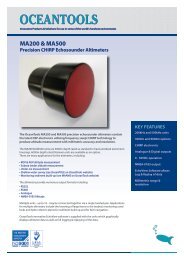

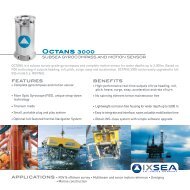
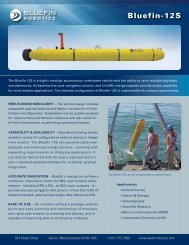
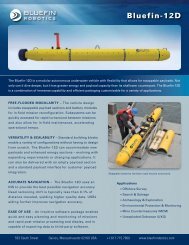


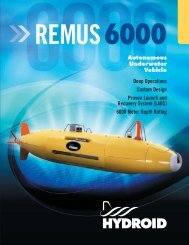


![Sonardyne Wideband Sub-Mini 6 [8270, 8271].pdf - AUVAC](https://img.yumpu.com/44408971/1/190x245/sonardyne-wideband-sub-mini-6-8270-8271pdf-auvac.jpg?quality=85)


